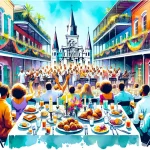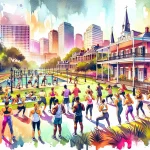New Orleans, renowned for its festive spirit, hosts the annual Gay Easter Parade, a celebration of fashion, creativity, and LGBTQ+ pride. This unique event began in 2000 and has become a cherished tradition showcasing the diversity and resilience of the local LGBTQ+ community. The parade takes place on Easter Sunday, typically in early to mid-April, attracting thousands of participants and spectators from around the world.
In This Article
TL;DR
- The Gay Easter Parade promotes LGBTQ+ visibility and community solidarity in New Orleans.
- The weekend features the main parade, pre-parade events, and post-parade gatherings.
- Planning ahead, choosing prime viewing spots, and engaging with the local LGBTQ+ community enhance the overall experience.
Historical Context and Significance
The parade traces its origins back to 2000 when a group of friends created an inclusive event showcasing the LGBTQ+ community’s fashion and creativity. Over the years, it has grown into a beloved annual tradition celebrating diversity and promoting acceptance.
The parade promotes LGBTQ+ visibility and community solidarity, providing a platform for individuals to express themselves freely and connect with others sharing similar experiences and values. It serves as a reminder of the ongoing struggle for LGBTQ+ rights and the importance of creating safe, welcoming spaces for all.
Key figures and organizations have been instrumental in shaping the Gay Easter Parade, including the founders, local activists, and community leaders who have worked tirelessly to ensure its success and longevity.
Main Events of the Parade Weekend
The parade procession winds through the historic French Quarter on Easter Sunday, typically starting at the corner of N. Rampart and St. Ann Streets and ending at GrandPre’s, a popular LGBTQ+-friendly bar.
The parade features colorful floats, marching groups, and elaborately costumed participants in Easter-themed attire. Ladies often wear elegant gowns or summer suits with extravagant Easter hats, while gentlemen may opt for dapper summer suits or tuxedos. The creativity and artistry on display are truly breathtaking.
In addition to the main parade, there are pre-parade events like brunches, cocktail parties, and social gatherings, as well as post-parade parties and fundraisers supporting local LGBTQ+ organizations.
Planning Your Visit
To make the most of your experience, plan ahead by choosing the best viewing spot along the parade route. Popular locations include balconies of gay-owned bars and restaurants on Bourbon Street or the final stretch near GrandPre’s. Arrive early to secure a prime spot.
Book accommodation near the French Quarter well in advance, as options fill up quickly. Top picks include the Bourbon Orleans Hotel, Royal Sonesta New Orleans, and Hotel Monteleone.
Use public transportation, ride-sharing services, or secure parking in advance, as many streets are closed to vehicular traffic during the busy parade weekend.
Cultural and Community Impact
The Gay Easter Parade celebrates New Orleans’ vibrant LGBTQ+ community and spirit of inclusivity and acceptance. It fosters a sense of pride and belonging, providing a safe and welcoming space for individuals to express themselves and connect with others sharing similar experiences and values.
The parade weekend has a significant economic impact on local businesses, particularly those catering to the LGBTQ+ community. The increased foot traffic and spending support the local economy.
Many local LGBTQ+ organizations use the event to raise awareness and collect donations for various initiatives, such as the “Bunnies in the Big Easy” fundraiser supporting Food for Friends, which provides meals to individuals with HIV/AIDS and other chronic illnesses.
Safety and Accessibility
The organizers prioritize the safety and well-being of all participants and spectators. The event is closely coordinated with local law enforcement and emergency services to provide a secure environment. Police officers and security personnel monitor crowd control and respond to any potential issues or emergencies.
Designated accessible viewing areas are set up along the route to accommodate individuals with disabilities, ensuring everyone has an opportunity to enjoy the festivities. These areas are staffed by volunteers who can provide assistance as needed.
First-time attendees should prioritize personal safety and responsible behavior during the parade weekend, including staying hydrated, wearing sunscreen, pacing alcohol consumption, and being aware of their surroundings.
Side Events and Activities
While the Gay Easter Parade is the centerpiece, there are plenty of other LGBTQ+-related events and activities to enjoy in New Orleans during this time. Many local bars and clubs host special parties and performances, providing opportunities to immerse in the city’s vibrant nightlife scene.
Visitors interested in New Orleans’ cultural heritage can explore museums and historical sites offering insights into the city’s past and present. The New Orleans Museum of Art often features exhibitions highlighting LGBTQ+ artists and activists’ contributions, while the LGBT Community Center of New Orleans hosts events and workshops during the Easter weekend.
Foodies will delight in the array of culinary offerings available during the parade weekend. Many restaurants and cafes offer special menus and promotions, including notable LGBTQ+-friendly establishments like The Bourbon Pub and Café Lafitte in Exile, the oldest continuously operating gay bar in the United States.
Engaging with the Community
Attending the Gay Easter Parade provides an opportunity to engage with the local LGBTQ+ community and show support for their efforts to promote equality and acceptance. Visitors can get involved by volunteering, participating in the procession itself, or simply cheering from the sidelines.
Those wanting to take their engagement further can volunteer or donate to local LGBTQ+ organizations like the New Orleans LGBT Community Center, which provides services and resources, or BreakOUT!, a youth-led organization advocating for LGBTQ+ rights and social justice.
When interacting with the local community and fellow attendees, approach the experience with an open mind, respectful attitude, and inclusive language. Foster a spirit of empathy and understanding to create a welcoming and inclusive atmosphere reflecting the true essence of the Gay Easter Parade.
The Gay Easter Parade Weekend in New Orleans is a vibrant and joyful celebration of LGBTQ+ pride, resilience, and creativity. By immersing themselves in the festivities, engaging with the local community, and exploring the city’s rich cultural heritage, visitors can experience the true spirit of New Orleans and create lasting memories of this unique and unforgettable event.






